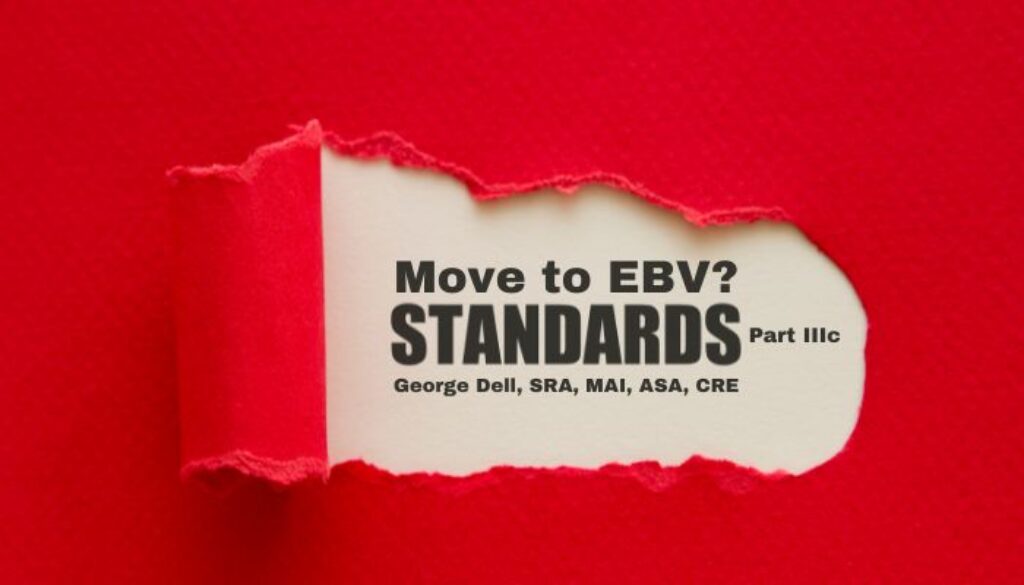Standards enforce appraisal review as well as development and reporting.
Editor’s Note: This is Standards, part 3.3 of George Dell’s series on How Do I Move to EBV? Links to the earlier posts are here.
This is the third part topic of the larger topic of how standards may help or hinder the move into modern analytic methods and results. We call this EBV© (Evidence Based Valuation). We copyright this term to prevent its misuse and abuse academically and commercially. EBV is the science of data as applied to asset analyses and decisioning.
Here we consider the USPAP requirement for “review” – as opposed to “audit” as enabled by EBV.
- Review is defined as “the act or process of developing an opinion about the quality of another appraiser’s work.” (USPAP definitions)
- Audit is defined as “an objective examination and evaluation,” as it applies to financial or business records.
Note that the standard emphasizes a personal “opinion,” while audit emphasizes objective examination. The appraisal standard focuses on the individual, while a business audit focuses on the document.
The main difference between appraisal review and valuation audit is reproducibility. In other words, in EBV, a second valuer can repeat (or replicate) the appraiser’s actions and arrive at the same or measurably similar result.
A critical issue with the use of USPAP for regulation – is that the reviewer’s opinion of the appraiser’s work is itself a wholly subjective opinion. Such an opinion — e.g., that USPAP law has been violated — is strictly another’s opinion of whether the appraiser’s opinion is “complete, accurate, adequate, relevant, and reasonable”.
Each of these criteria – completeness, accuracy, adequacy, relevance, and reasonableness — require the “reviewer” to form a separate opinion. If the reviewer’s opinion differs from the appraiser’s opinion, this is called a “USPAP violation” in administrative law. Then the accused appraiser is presumed to be in violation, needing to prove their work worthy of belief” to another.
Review is subjective. Audit is substantially objective. How is that a good thing?
Reproducible, auditable EBV means that a reliability score can be attached to each valuation! And when a consistent score can be attached, it means that a risk measure can be implemented.
And if a risk measure can be calculated, then the whole process is goal directed. Clients, regulators, administrators – all need to know risk. Risk of collateral loss, risk of not achieving investment goals, or risk of an unfair outcome for taxpayers, judiciary, or minority groups.
For users, especially lenders, it means a direct measure of risk, rather than a past-facing opinion of an unprovable point value. For regulators and bank auditors, it clarifies and relates the collateral risk issue with other risk issues. In particular, the risk of economic turndown can be accounted for!
For the appraiser, EBV requires some unlearning. An understanding of the imprisonment of our acts and behaviors to the outdated, obsolete process is needed to open the mind to better, faster, more accurate results.
The move to EBV requires the ability to select and analyze larger data sets – the complete market segment. The move to EBV requires questioning the old “generally accepted” process. It requires a bit of learning: of visuals, computer calculations, and economic relationships.
The payoff is good, and much more fun!

June 14, 2023 @ 12:08 pm
A review just like an audit must verify the facts first. Is the subject and comparable data factually correct? If not then the appraisal must be rejected and a new appraisal ordered or sent back for correction. The difference between rejection and correction is typically the degree of error and fraud (data that is not verifiable or an outright lie). Large data sets are going to be time consuming to fact check, whether it’s an audit or a review. In my world we review every single appraisal, and we go to court on a regular basis. In my experience audits are just as subjective as a review, either can be thorough or a rubber stamp (and I have had to deal with the consequences of the later). You emphasize in your EBV approach, repeatability of the conclusion and I applaud that. I was taught that a review was just that, could the reader follow the appraisal from start to finish and reach the same conclusion. An appraisal should be written to such a degree that the opposing side never wants to show up in court against you (which has happened several times as we waited at the courtroom door). How do you do that, get your facts right (math, verifications, all of it) and it generally makes the appraisal simple.
I have never seen an attorney bring up USPAP in court, mediation or arbitration.
Are you asking that USPAP change the definition of a review or add an audit function to the review? Or are you saying that there is no need for reviews?